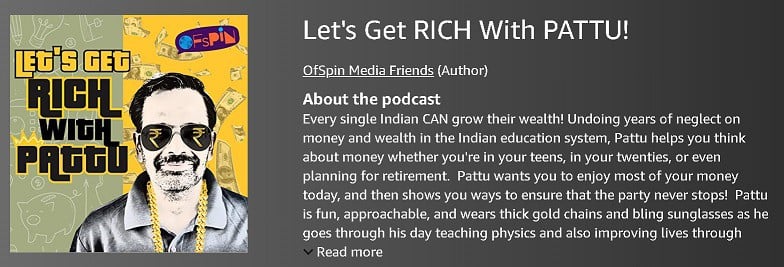In this article, we see how a lower expense ratio does not necessarily mean more gains for the investor using the example of two index funds: the NAVI Nifty 50 Index fund (direct plan) and the UTI Nifty 50 Index fund (direct plan) and the last one year period.
It must be understood that the motive behind this article is only to highlight some counterintuitive features of passive funds. It should not be construed as a recommendation of one fund over another. The NAVI fund is too young to be dismissed or recommended.
Navi Nifty 50 Index Fund: Started in July 2021, the fund has an impressive AUM of about 571 Crores. Much of this AUM came due to the advertised “lowest fee”. The fund, since inception, has maintained a total expense ratio (TER) of only 0.06%
UTI Nifty 50 Index Fund: This has an AUM of about 8,941 Crores, and during the last year, the funds’ TER has fluctuated from 0.21% to 0.18% with an average TER of about 0.2%. The fund was started in March 2000, but as is common knowledge, much of its AUM is a recent acquisition. The fund notoriously doubled its TER (0.1% in March 2021 to 0.2% in May 2021) but still managed to stay on top in terms of performance.
Notice that the tracking error does not differentiate between the two funds. This is because removing a constant TER from the NAV does not affect the tracking error, which is a measure of relative volatility wrt the benchmark. We ask readers to focus on the tracking difference (fund return minus benchmark return) and use it in our monthly index fund screeners.
Join 32,000+ readers and get free money management solutions delivered to your inbox! Subscribe to get posts via email! (Link takes you to our email sign-up form)
🔥Want to create a complete financial plan? Learn goal-based investing? Exclusive access to our DIY tools? Increase your income with your skills? Enjoy massive discounts on our robo-advisory tool & courses! 🔥
| Scheme Name | Tracking error 11-Nov-2021 To 11-Nov-2022 |
| UTI Nifty 50 Index Fund(G)-Direct Plan | 0.0432 |
| Navi Nifty 50 Index Fund(G)-Direct Plan | 0.0437 |
This is the trailing performance of the two funds compared with Nifty 50 TRI
| Scheme Name | 3 Months | 6 Months |
| Navi Nifty 50 Index Fund(G)-Direct Plan | 4.0816 | 14.5493 |
| UTI Nifty 50 Index Fund(G)-Direct Plan | 4.0868 | 14.5644 |
| NIFTY 50 – TRI | 4.1400 | 14.7067 |
| Scheme Name | 9 Months | 1 Year |
| Navi Nifty 50 Index Fund(G)-Direct Plan | 6.6740 | 3.7819 |
| UTI Nifty 50 Index Fund(G)-Direct Plan | 6.7076 | 3.8107 |
| NIFTY 50 – TRI | 6.9047 | 4.0658 |
The UTI fund, with a TER more than three times that of the NAV fund, has managed to perform just as well. How is this possible?
(1) All index funds can invest in “money market instruments” up to 5% of the portfolio to handle cash in and outflows. These can be a variety of instruments like short-term deposits, treasury bills, commercial paper, tri-party repo, securities lending etc. The fund can choose these instruments per prevailing market or economic conditions.
A fund with a higher return from this money market component can easily offset its higher TER and produce a better or comparable return to a fund with a lower TER. Of course, this comes with some settlement risk and can backfire under extreme market conditions. This is a more or less steady return and will not contribute much to the tracking error.
(2) Another possible reason is the impact cost. The buy-price and sell-price of stock in the market often depend on the quantity sold. This results in a loss or a gain for the buyer/seller. For more details, see Warning! Even “large cap” stocks are not liquid enough!
For a stock to be eligible for inclusion in the Nifty 50, its average impact cost should be 0.5% or less for 90% of its transactions over the last six months for a basket size of Rs. 2 crores. The impact costs of the top few stocks of the Nifty are the lowest, but they do increase by two to three-fold as the market capitalization decreases. The NSE provides monthly impact cost reports for both the Nifty 50 and Nifty Next 50 (The next 50 stocks have a much higher impact cost and, therefore, should not be classified as “large cap”).
These impact costs or demand-supply losses may be lower (especially for top Nifty 50 stocks) for a fund with a large AUM since their buy/sell orders are larger. However, this cannot be quantified easily (at least by us) and therefore remains speculation.
This discussion also has another aspect. UTI Nifty 50 index fund can compete with NAVI Nifty 50 index fund despite being three times more expensive. This is largely due to how well they manage their cash component. But does this mean they are taking more risks to enable them to maintain a higher TER? Does this mean it can hurt investors (by a small amount)? This is certainly a possibility. Only time can tell.
🔥Enjoy massive discounts on our courses, robo-advisory tool and exclusive investor circle! 🔥& join our community of 7000+ users!
Use our Robo-advisory Tool for a start-to-finish financial plan! ⇐ More than 2,500 investors and advisors use this!
Track your mutual funds and stock investments with this Google Sheet!
We also publish monthly equity mutual funds, debt and hybrid mutual funds, index funds and ETF screeners and momentum, low-volatility stock screeners.





- Do you have a comment about the above article? Reach out to us on Twitter: @freefincal or @pattufreefincal
- Have a question? Subscribe to our newsletter using the form below.
- Hit 'reply' to any email from us! We do not offer personalized investment advice. We can write a detailed article without mentioning your name if you have a generic question.
Join 32,000+ readers and get free money management solutions delivered to your inbox! Subscribe to get posts via email! (Link takes you to our email sign-up form)
About The Author
 Dr M. Pattabiraman(PhD) is the founder, managing editor and primary author of freefincal. He is an associate professor at the Indian Institute of Technology, Madras. He has over ten years of experience publishing news analysis, research and financial product development. Connect with him via Twitter(X), Linkedin, or YouTube. Pattabiraman has co-authored three print books: (1) You can be rich too with goal-based investing (CNBC TV18) for DIY investors. (2) Gamechanger for young earners. (3) Chinchu Gets a Superpower! for kids. He has also written seven other free e-books on various money management topics. He is a patron and co-founder of “Fee-only India,” an organisation promoting unbiased, commission-free investment advice.
Dr M. Pattabiraman(PhD) is the founder, managing editor and primary author of freefincal. He is an associate professor at the Indian Institute of Technology, Madras. He has over ten years of experience publishing news analysis, research and financial product development. Connect with him via Twitter(X), Linkedin, or YouTube. Pattabiraman has co-authored three print books: (1) You can be rich too with goal-based investing (CNBC TV18) for DIY investors. (2) Gamechanger for young earners. (3) Chinchu Gets a Superpower! for kids. He has also written seven other free e-books on various money management topics. He is a patron and co-founder of “Fee-only India,” an organisation promoting unbiased, commission-free investment advice.Our flagship course! Learn to manage your portfolio like a pro to achieve your goals regardless of market conditions! ⇐ More than 3,000 investors and advisors are part of our exclusive community! Get clarity on how to plan for your goals and achieve the necessary corpus no matter the market condition is!! Watch the first lecture for free! One-time payment! No recurring fees! Life-long access to videos! Reduce fear, uncertainty and doubt while investing! Learn how to plan for your goals before and after retirement with confidence.
Our new course! Increase your income by getting people to pay for your skills! ⇐ More than 700 salaried employees, entrepreneurs and financial advisors are part of our exclusive community! Learn how to get people to pay for your skills! Whether you are a professional or small business owner who wants more clients via online visibility or a salaried person wanting a side income or passive income, we will show you how to achieve this by showcasing your skills and building a community that trusts and pays you! (watch 1st lecture for free). One-time payment! No recurring fees! Life-long access to videos!
Our new book for kids: “Chinchu Gets a Superpower!” is now available!


Must-read book even for adults! This is something that every parent should teach their kids right from their young age. The importance of money management and decision making based on their wants and needs. Very nicely written in simple terms. - Arun.Buy the book: Chinchu gets a superpower for your child!
How to profit from content writing: Our new ebook is for those interested in getting side income via content writing. It is available at a 50% discount for Rs. 500 only!
Do you want to check if the market is overvalued or undervalued? Use our market valuation tool (it will work with any index!), or get the Tactical Buy/Sell timing tool!
We publish monthly mutual fund screeners and momentum, low-volatility stock screeners.
About freefincal & its content policy. Freefincal is a News Media Organization dedicated to providing original analysis, reports, reviews and insights on mutual funds, stocks, investing, retirement and personal finance developments. We do so without conflict of interest and bias. Follow us on Google News. Freefincal serves more than three million readers a year (5 million page views) with articles based only on factual information and detailed analysis by its authors. All statements made will be verified with credible and knowledgeable sources before publication. Freefincal does not publish paid articles, promotions, PR, satire or opinions without data. All opinions will be inferences backed by verifiable, reproducible evidence/data. Contact information: To get in touch, use this contact form. (Sponsored posts or paid collaborations will not be entertained.)
Connect with us on social media
- Twitter @freefincal
- Subscribe to our YouTube Videos
- Posts feed via Feedburner.
Our publications
You Can Be Rich Too with Goal-Based Investing
 Published by CNBC TV18, this book is meant to help you ask the right questions and seek the correct answers, and since it comes with nine online calculators, you can also create custom solutions for your lifestyle! Get it now.
Published by CNBC TV18, this book is meant to help you ask the right questions and seek the correct answers, and since it comes with nine online calculators, you can also create custom solutions for your lifestyle! Get it now.Gamechanger: Forget Startups, Join Corporate & Still Live the Rich Life You Want
 This book is meant for young earners to get their basics right from day one! It will also help you travel to exotic places at a low cost! Get it or gift it to a young earner.
This book is meant for young earners to get their basics right from day one! It will also help you travel to exotic places at a low cost! Get it or gift it to a young earner.Your Ultimate Guide to Travel
 This is an in-depth dive into vacation planning, finding cheap flights, budget accommodation, what to do when travelling, and how travelling slowly is better financially and psychologically, with links to the web pages and hand-holding at every step. Get the pdf for Rs 300 (instant download)
This is an in-depth dive into vacation planning, finding cheap flights, budget accommodation, what to do when travelling, and how travelling slowly is better financially and psychologically, with links to the web pages and hand-holding at every step. Get the pdf for Rs 300 (instant download)